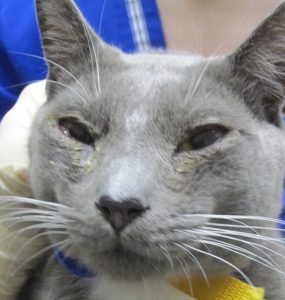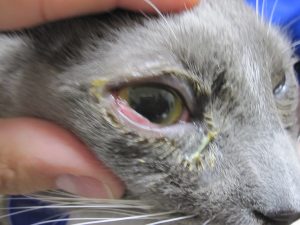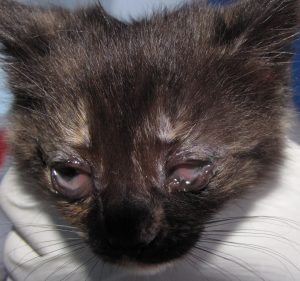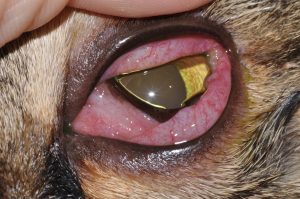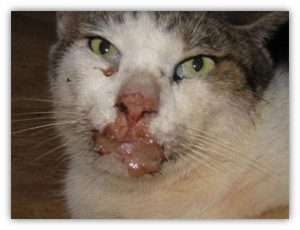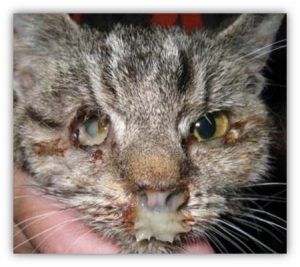Module 4: Healthcare practices for common contagious infectious diseases
Clinical Features of Feline URI Pathogens
FHV and FCV
FHV causes rhinitis, conjunctivitis, keratitis, stomatitis, and facial dermatitis resulting in sneezing, oculo/nasal discharge, corneal ulcers, oral ulcers, and hypersalivation from pharyngitis and oral ulcers. Clinical disease can persist for 1 to 3 weeks depending on severity of symptoms. Kittens typically have more severe disease than adults, including pneumonia.
FCV infection also causes sneezing, oculo/nasal discharge, oral ulcers, and hypersalivation from pharyngitis and oral ulcers. However, FCV does not cause corneal ulcers. Kittens typically have more severe disease than adults, including pneumonia and the limping syndrome due to viral replication in joints. Clinical signs typically persist for 1 to 3 weeks or longer.
In most cases, FCV and FHV infections cannot be distinguished based on clinical signs. Both viruses cause severe oral ulcers that are very painful. However, only FHV causes keratitis and corneal ulcers. Co-infections with both viruses occur commonly in shelters.
Test Your Knowledge
Watch This
Chlamydia, Bordetella, Mycoplasma felis, Strep zoo.
Chlamydia bacterial infections are not as common as FHV and FCV infection. Chlamydia infects the eye to cause conjunctivitis, chemosis, blepharospasm, and purulent ocular discharge.
-
Conjunctivitis due to Chlamydia
-
Conjunctivitis, chemosis, and purulent ocular discharge from Chlamydia infection
-
Chlamydia infection in a kitten
-
Severe chemosis due to Chlamydia infection
Bordetella infection is uncommon in cats but this bacterial infection is one of the few conditions that cause cats to cough (other conditions include asthma and heartworm infection). Clinical signs include sneezing and nasal discharge, and coughing is a unique indicator of Bordetella infection in cats. Bordetella infection causes severe life-threatening pneumonia in kittens. Cats can acquire Bordetella infection from infected dogs in the shelter, mostly through indirect contact with contaminated surfaces and staff.
The ability of Mycoplasma felis (M felis) to initiate primary respiratory infection is unclear but this bacterium is a frequent co-infection in cats infected with FHV or FCV. This secondary bacterial infection can contribute to severity and duration of disease.
The antibiotics of choice for eliminating Chlamydia, Bordetella, and M felis infections are doxycycline and minocycline for 2 weeks.
Strep zoo is an emerging pathogen in cats housed in sanctuaries and large-scale hoarding conditions where respiratory disease is rampant. Strep zoo has been identified in cats with severe life-threatening URI and pneumonia. The bacteria infect the nose, lungs, and brain. Unlike Strep zoo infection of dogs, pulmonary hemorrhage is not a characteristic of the infection in cats. The best antibiotics for Strep zoo infections in cats are Clavamox and Convenia.
Here are two cats from a hoarding situation that have severe respiratory disease, including pneumonia, from Strep zoo co-infection with FCV.
-
An adult cat with severe respiratory disease due to Strep zoo co-infection with FCV
-
Another adult cat with Strep zoo co-infection with FCV
Test Your Knowledge

